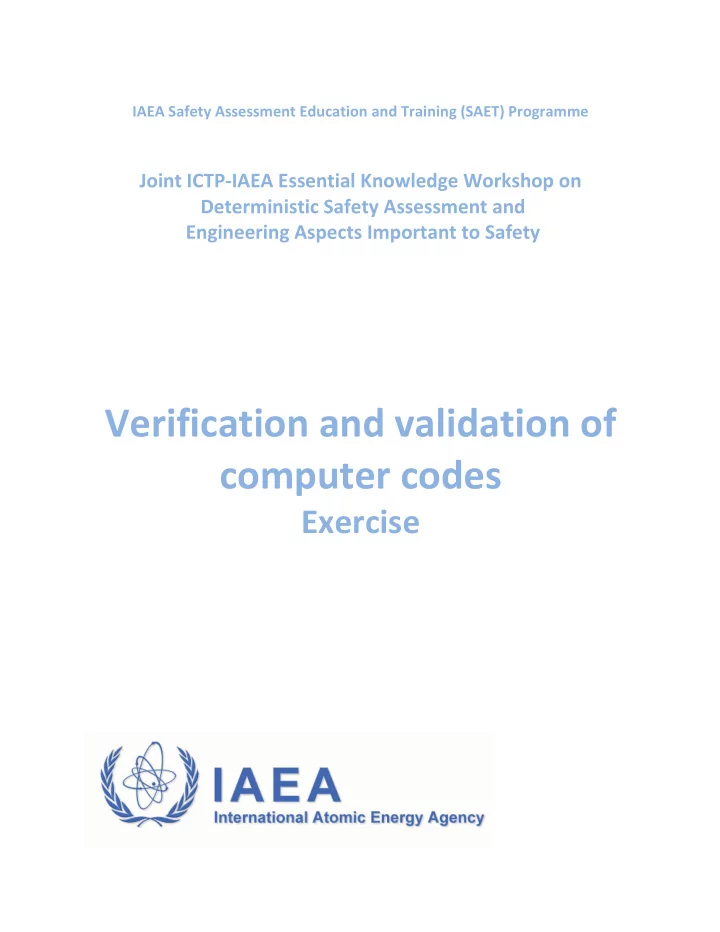

¡ IAEA ¡Safety ¡Assessment ¡Education ¡and ¡Training ¡(SAET) ¡Programme ¡ ¡ ¡ Joint ¡ICTP-‑IAEA ¡Essential ¡Knowledge ¡Workshop ¡on ¡ ¡ ¡Deterministic ¡Safety ¡Assessment ¡and ¡ ¡ ¡Engineering ¡Aspects ¡Important ¡to ¡Safety ¡ Verification ¡and ¡validation ¡of ¡ computer ¡codes ¡ Exercise ¡ ¡ ¡ ¡ ¡ ¡ ¡ ¡ ¡ ¡ ¡ ¡ ¡
IAEA SAET – EK DSA V&V Exercises ¡on ¡verification ¡and ¡validation ¡of ¡computer ¡codes ¡(V&V) ¡ ¡ Computer ¡codes ¡like ¡RELAP5, ¡ATHLET, ¡CATHARE ¡etc. ¡aim ¡to ¡simulate ¡the ¡system ¡behavior ¡of ¡ nuclear ¡power ¡plants ¡as ¡realistic ¡as ¡possible ¡(’best ¡estimate’). ¡These ¡computer ¡codes ¡are ¡used ¡to ¡ investigate ¡ − ¡ incidents ¡ and ¡ accidents ¡ of ¡ different ¡ scenarios ¡ and ¡ their ¡ consequences, ¡ − ¡ the ¡ effectiveness ¡of ¡emergency ¡procedures. ¡ ¡ The ¡ process ¡ carried ¡ out ¡ by ¡ comparing ¡ code ¡ predictions ¡ with ¡ experimental ¡ measurements ¡ or ¡ measurements ¡ in ¡ a ¡ reactor ¡ plant ¡ (if ¡ available) ¡ is ¡ called ¡ validation. ¡ A ¡ code ¡ or ¡ code ¡ model ¡ is ¡ considered ¡validated ¡when ¡sufficient ¡testing ¡has ¡been ¡performed ¡to ¡ensure ¡an ¡acceptable ¡level ¡ of ¡predictive ¡accuracy ¡over ¡the ¡range ¡of ¡conditions ¡for ¡which ¡the ¡code ¡may ¡be ¡applied. ¡Accuracy ¡ is ¡a ¡measure ¡of ¡the ¡difference ¡between ¡measured ¡and ¡calculated ¡quantities ¡taking ¡into ¡account ¡ uncertainties ¡ and ¡ biases ¡ in ¡ both. ¡ Bias ¡ is ¡ a ¡ measure, ¡ usually ¡ expressed ¡ statistically, ¡ of ¡ the ¡ systematic ¡ difference ¡ between ¡ a ¡ true ¡ mean ¡ value ¡ and ¡ a ¡ predicted ¡ or ¡ measured ¡ mean. ¡ Uncertainty ¡is ¡a ¡measure ¡of ¡the ¡scatter ¡in ¡experimental ¡or ¡predicted ¡data. ¡The ¡acceptable ¡level ¡ of ¡accuracy ¡is ¡judgmental ¡and ¡will ¡vary ¡depending ¡on ¡the ¡specific ¡problem ¡or ¡question ¡to ¡be ¡ addressed ¡ by ¡ the ¡ code. ¡ The ¡ procedure ¡ for ¡ specifying, ¡ qualitatively ¡ or ¡ quantitatively, ¡ the ¡ accuracy ¡of ¡code ¡predictions ¡is ¡also ¡called ¡code ¡assessment. ¡ ¡ The ¡validation ¡of ¡codes ¡is ¡mainly ¡based ¡on ¡pre-‑test ¡and ¡post-‑test ¡calculations ¡of ¡separate ¡effects ¡ tests, ¡integral ¡system ¡tests, ¡and ¡transients ¡in ¡commercial ¡plants. ¡An ¡enormous ¡amount ¡of ¡test ¡ data, ¡usable ¡for ¡code ¡validation, ¡has ¡been ¡accumulated ¡in ¡the ¡last ¡decades. ¡In ¡the ¡year ¡1987 ¡the ¡ Committee ¡on ¡the ¡Safety ¡of ¡Nuclear ¡Installations ¡(CSNI) ¡of ¡the ¡Nuclear ¡Energy ¡Agency ¡(NEA) ¡in ¡ the ¡Organisation ¡for ¡Economic ¡Co-‑Operation ¡and ¡Development ¡(OECD) ¡issued ¡a ¡report ¡compiled ¡ by ¡the ¡Task ¡Group ¡on ¡the ¡Status ¡and ¡Assessment ¡of ¡Codes ¡for ¡Transients ¡and ¡ECC. ¡It ¡contains ¡ proposed ¡validation ¡matrices ¡for ¡LOCA ¡and ¡transients, ¡consisting ¡of ¡the ¡dominating ¡phenomena ¡ and ¡ the ¡ available ¡ test ¡ facilities, ¡ and ¡ the ¡ selected ¡ experiments. ¡ The ¡ Task ¡ Group ¡ on ¡ Thermal ¡ Hydraulic ¡ System ¡ Behavior ¡ updated ¡ the ¡ integral ¡ test ¡ matrices ¡ and ¡ extended ¡ their ¡ work ¡ to ¡ separate ¡effects ¡tests. ¡ ¡ ¡ 2
IAEA SAET – EK DSA V&V Tasks ¡to ¡be ¡performed ¡ ¡ 1. Review ¡the ¡provided ¡description ¡of ¡computer ¡code ¡simulation ¡of ¡selected ¡PIEs ¡(SB ¡LOCA ¡and ¡ LB ¡LOCA). ¡ 2. From ¡the ¡description ¡identify ¡the ¡phenomena, ¡which ¡occur ¡during ¡the ¡PIEs. ¡ 3. Using ¡the ¡information ¡provided ¡in ¡OECD/NEA ¡computer ¡code ¡validation ¡matrix ¡relevant ¡for ¡ the ¡ simulated ¡ PIE, ¡ identify ¡ the ¡ integral ¡ test ¡ facilities ¡ and ¡ experiments ¡ suitable ¡ for ¡ the ¡ computer ¡code ¡validation. ¡ 4. Review ¡the ¡provided ¡plots ¡with ¡results ¡of ¡the ¡computer ¡code ¡simulation ¡and ¡its ¡comparison ¡ against ¡ relevant ¡ experiment. ¡ Provide ¡ the ¡ judgment ¡ on ¡ qualitative ¡ and ¡ quantitative ¡ code ¡ accuracy ¡using ¡the ¡following ¡scale: ¡ E: ¡ excellent, ¡if ¡code ¡predicts ¡qualitatively ¡and ¡quantitatively ¡the ¡phenomena/parameter ¡ R: ¡ reasonable, ¡ if ¡ code ¡ predicts ¡ qualitatively ¡ but ¡ not ¡ quantitatively ¡ the ¡ phenomena/parameter ¡ M: ¡ minimal, ¡ if ¡ code ¡ does ¡ not ¡ predicts ¡ the ¡ phenomena/parameter, ¡ but ¡ the ¡ reason ¡ is ¡ understood ¡and ¡predictable) ¡ U: ¡unqualified, ¡if ¡code ¡does ¡not ¡predicts ¡the ¡phenomena/parameter ¡and ¡the ¡reason ¡is ¡not ¡ understood ¡ ¡ ¡ ¡ 3
Recommend
More recommend